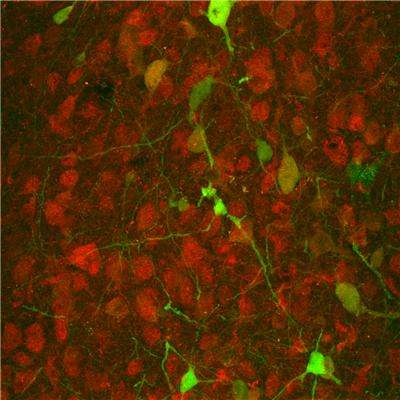Switching off anxiety with light

Receptors for the messenger molecule serotonin can be modified in such a way that they can be activated by light. Together with colleagues, neuroscientists from the Ruhr-Universität Bochum (RUB) report on this finding in the journal Neuron. An imbalance in serotonin levels seems to cause anxiety and depression. The researchers have provided a new model system for investigating the mechanism underlying these dysfunctions in cell cultures as well as living organisms.
G protein coupled receptors play an important role in medicine and health
One receptor, which is important for the regulation of serotonin levels in the brain, is the 5-HT1A receptor. It belongs to a protein family called G protein coupled receptors (GPCRs). These receptors can activate different signalling pathways in cells to support or suppress various signalling events. "About 30 per cent of the current drugs target specifically GPCRs", says Prof Dr Stefan Herlitze from the Department of General Zoology and Neurobiology at the RUB. Due to the lack of tools to control intracellular signalling pathways with high temporal and spatial accuracy, it was so far difficult to analyse these pathways precisely.
Coupling of visual pigments to serotonin receptors
Applying optogenetic methods the scientists in Bochum used cone opsins from the mouse and human eye to control specifically serotonin signalling pathways either with blue or red light. Prof Dr Stefan Herlitze has been working with optogenetic techniques since 2005 and is one of the pioneers in the field. The light-activated serotonin receptors can be switched on within milliseconds, are extremely light sensitive in comparison to other optogenetic tools and can be repetitively activated. "We hope that with the help of these optogenetic tools, we will be able to gain a better understanding about how anxiety and depression originate", states RUB neuroscientist Dr Olivia Masseck.
Successful behavioural tests
The scientists also demonstrated that they were able to modulate mouse emotional behaviour using the light-activated receptors. When they switched on the serotonergic signals by light in a certain brain area, the mice became less anxious.
More information: O.A. Masseck, K. Spoida, D. Dalkara, T. Maejima, J.M. Rubelwoski, L. Wallhorn, E.S. Deneris, S. Herlitze (2014): Vertebrate cone opsins enable sustained and highly sensitive rapid control of Gi/o signaling in anxiety circuitry. Neuron, DOI: 10.1016/j.neuron.2014.01.041














